Behold the art of Jim Sitz, an 18-year-old Californian who was already steeped in racing knowledge and an expert photographer when arrived in Europe in the summer of that magical, epochal, dangerous year of 1957. Sitz was not wealthy, but worked and saved for two years in order to afford the trip that would change his life forever. And after 67 years his photographs and memories are still enriching our lives.
We have assembled a portrait gallery of fourteen of the greatest race drivers of the era, adding Jim’s personal recollections including his first-hand report of Fangio’s German Grand Prix. Also herein are Jean Behra, Mike Hawthorn, Luigi Musso, Stirling Moss, Peter Collins, Oliver Gendebien, Ron Flockhart, Archie Scott Brown, Masten Gregory, Wolfgang von Trips, Phil Hill, Harry Schell and Ken Miles.
Story and photos by Jim Sitz
Lead Photo: Masten Gregory (29 February 1932 – 8 November 1985) sitting in the Testa Rossa prototype before the 1957 Swedish 6 Hour on August 11 where the car was retired with gearbox failure. A week earlier at the Nurburgring I joked with him, saying he’d should be very careful and that I’d seen him spin his C type Jag at March Field in 1953. “Oh God, you mean you were there?” he replied.
Masten wore prescription glasses (and goggles) and always appeared to be younger than he was. Years later his widow told me that when they checked into a grand hotel in San Francisco for the 1953 race at Golden Gate, they refused to book them in as they looked like a couple of fourteen year old runaways. He had to call some SCCA official to confirm that he was really Masten Gregory and entered in the race, which he won the next day.
Gregory had inherited a bit of a fortune from his father, enabling him to buy and race cars around the world. In early 1953 he bought a C-Type Jag and in September bought his first Ferrari, a 340 Berlinetta, chassis 0202A, which he bought from Ernie McAfee. He raced in at Madera and placed third, but immediately returned it to McAfee, telling him to sell it.
In 1954 he went to Argentina with his C Type but ended up buying the winning Ferrari 375MM – chassis #0370AM- from Scuderia Ferrari, and took it to Pebble Beach where he hit a tree. He told both Phil Hill and Carroll Shelby that he was off to Europe and they laughed. But at Reims he finished fourth with the big Ferrari, driving with Clemente Biondetti. In 1955, he bought his third Ferrari, a 750 Monza, chassis 0554M.
My friend Jesse Alexander also had a large inheritance, and told me he learned a lesson watching Masten, who in addition to Ferraris, bought a villa in Italy. Masten’s daily transportation was a new Chevy convertible, painted a wheat color with Kansas license plates which must have been costly to own and operate in Europe. It was easy to see how Masten burned through his $500,000 inheritance so quickly. Jesse would be more prudent with his inheritance.
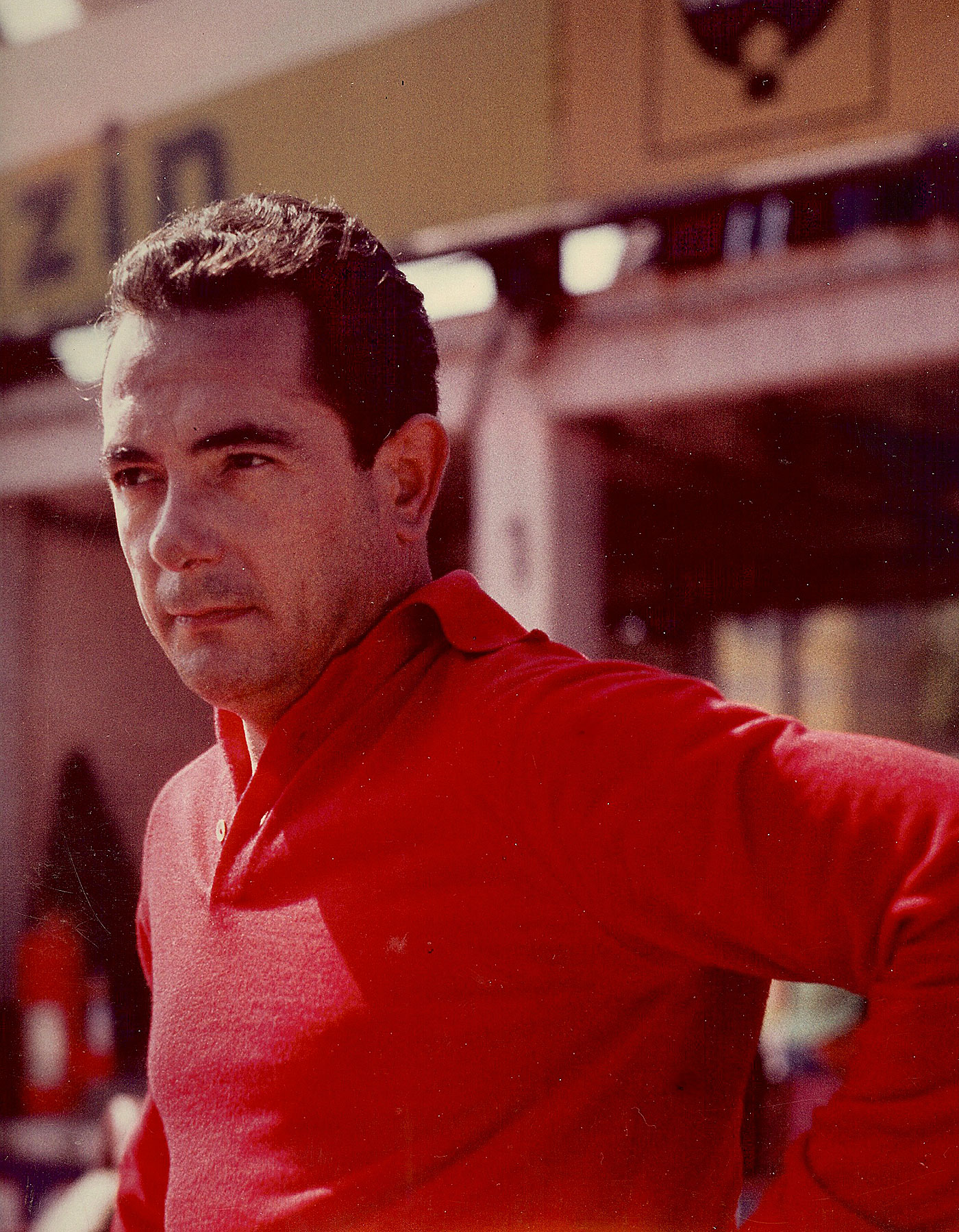 The proud Frenchman Jean Behra, (16 February 1921 – 1 August 1959) known as ‘The Third Man” (a popular movie at the time) since he could not match the pace of Maserati teammates Fangio and Moss. But the mechanics loved him for his supreme effort and as seen here at the German Grand Prix in 1957 he did get on the front row with Fangio, Collins and Hawthorn. The next year Behra traveled to Riverside to drive the new RSK Porsche. I was keen to tell him I had seen him drive the Maserati 250F, and he had a big smile when I showed him the photo I took of his win in Modena on September 22, 1957. Since I didn’t speak French, it was a bit of a shaky chat, but we managed. Behra also made friends that day in LA, where they were impressed with his driving skills at the Times GP.
The proud Frenchman Jean Behra, (16 February 1921 – 1 August 1959) known as ‘The Third Man” (a popular movie at the time) since he could not match the pace of Maserati teammates Fangio and Moss. But the mechanics loved him for his supreme effort and as seen here at the German Grand Prix in 1957 he did get on the front row with Fangio, Collins and Hawthorn. The next year Behra traveled to Riverside to drive the new RSK Porsche. I was keen to tell him I had seen him drive the Maserati 250F, and he had a big smile when I showed him the photo I took of his win in Modena on September 22, 1957. Since I didn’t speak French, it was a bit of a shaky chat, but we managed. Behra also made friends that day in LA, where they were impressed with his driving skills at the Times GP.
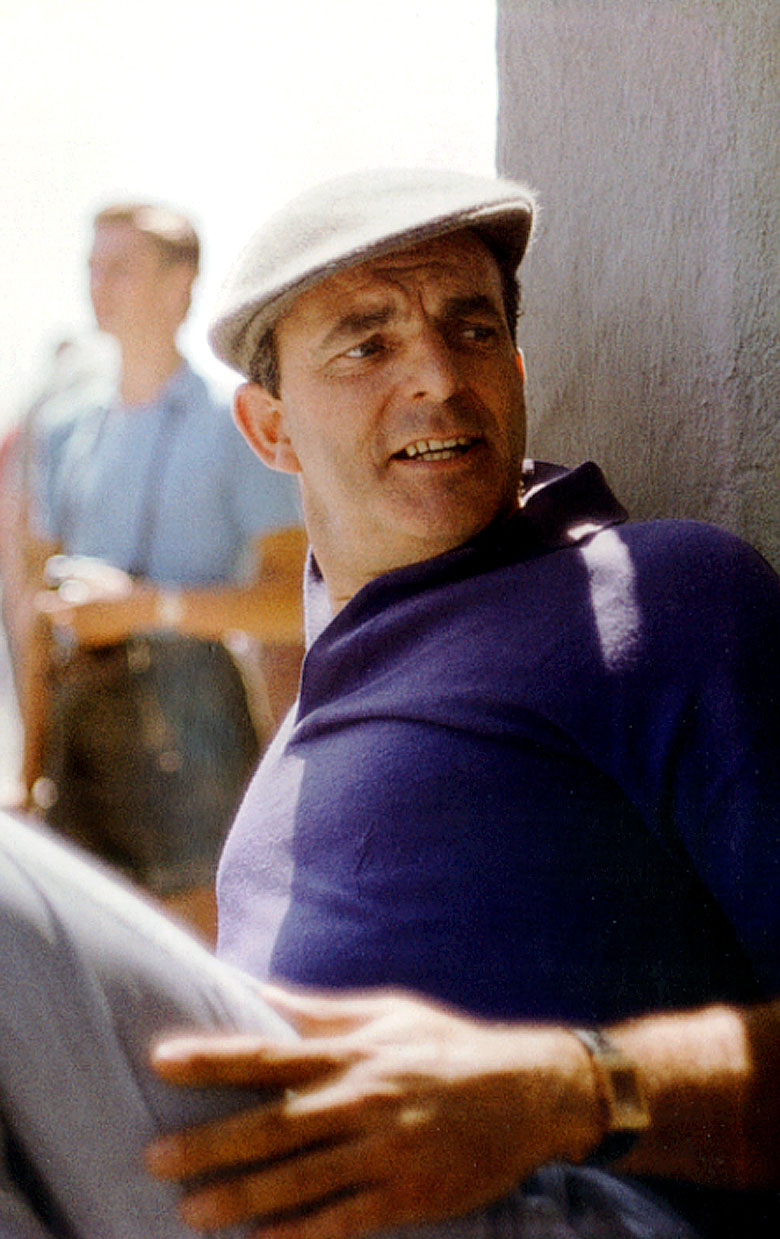 Harry Schell (29 June 1921 – 13 May 1960) our man in Paris, operated a bar there. His parents were running GP cars in France where Harry and brother Filipe spent most of their lives. Harry was always fast, though on some days faster than others, and in 1956 drove for Vanwall, leading at Reims and Monza, scaring the crap out of the Ferrari team. He and Jean Behra were great pals and both drove for Gordini, BRM, and Maserati.
Harry Schell (29 June 1921 – 13 May 1960) our man in Paris, operated a bar there. His parents were running GP cars in France where Harry and brother Filipe spent most of their lives. Harry was always fast, though on some days faster than others, and in 1956 drove for Vanwall, leading at Reims and Monza, scaring the crap out of the Ferrari team. He and Jean Behra were great pals and both drove for Gordini, BRM, and Maserati.
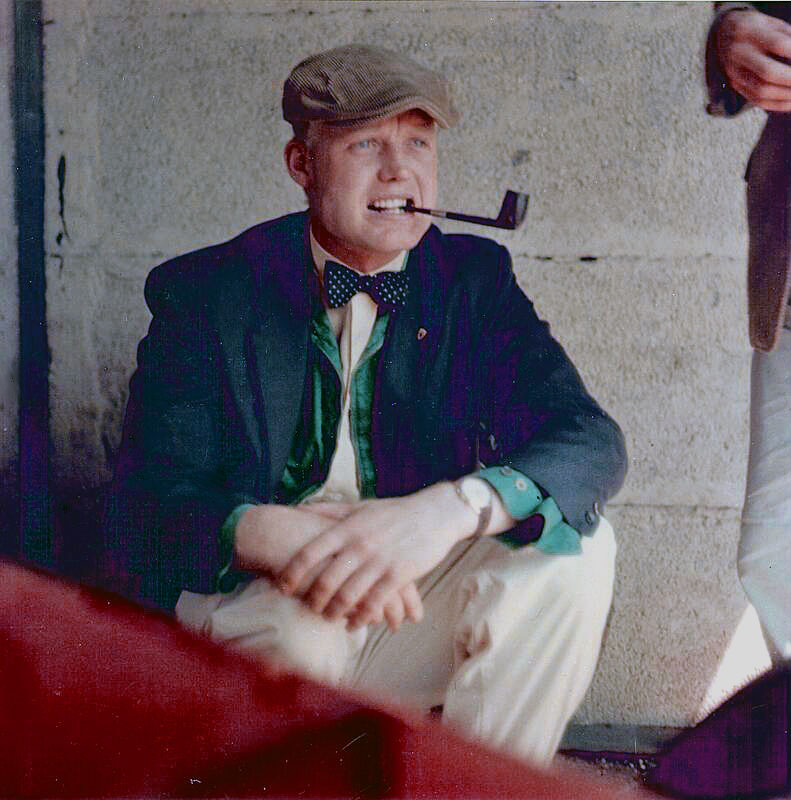 Mike Hawthorn (10 April 1929 – 22 January 1959) looking very British and in great form at the 1957 German Grand Prix. He seemed to have the race sewn up but in the final laps Fangio passed him to a roar from the crowds, which Phil Hill and I could easily hear from the pits. I never got a chance to know him since his moods were unpredictable then. But his year would come in 1958 when he won the World Championship by one point from Stirling Moss.
Mike Hawthorn (10 April 1929 – 22 January 1959) looking very British and in great form at the 1957 German Grand Prix. He seemed to have the race sewn up but in the final laps Fangio passed him to a roar from the crowds, which Phil Hill and I could easily hear from the pits. I never got a chance to know him since his moods were unpredictable then. But his year would come in 1958 when he won the World Championship by one point from Stirling Moss.
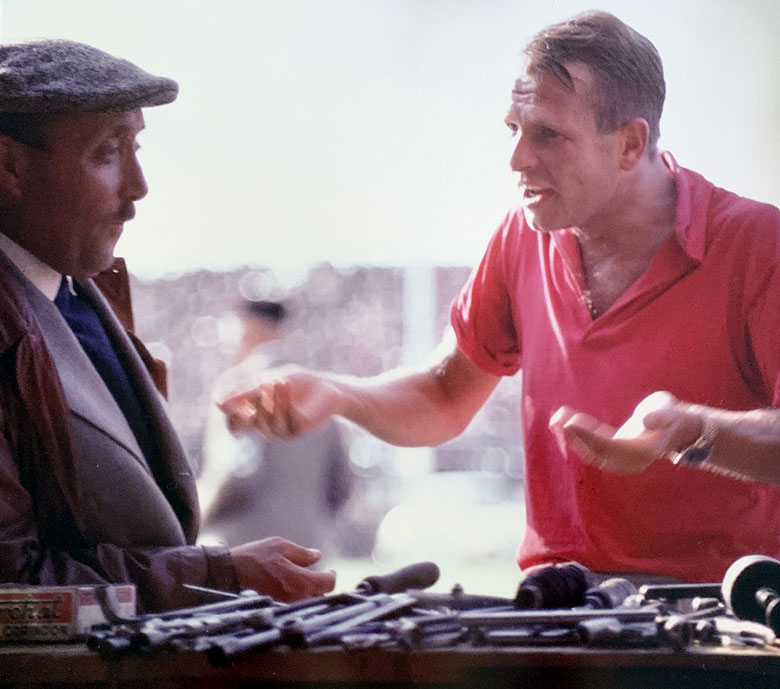 Peter Collins (6 November 1931 – 3 August 1958) I snapped Collins at Modena in the fall of 1957, trying to make Ferrari engineer Amorotti laugh, but I have no idea what Peter was relating. At that time, Hawthorn, Collins and Hill spoke English so the Italians had to be able to understand the language. I was still a bit shy and often took photos without speaking to the subjects.
Peter Collins (6 November 1931 – 3 August 1958) I snapped Collins at Modena in the fall of 1957, trying to make Ferrari engineer Amorotti laugh, but I have no idea what Peter was relating. At that time, Hawthorn, Collins and Hill spoke English so the Italians had to be able to understand the language. I was still a bit shy and often took photos without speaking to the subjects.
I had met Peter Collins a year before at Sebring. He had retired his Aston Martin close to where I was shooting so I walked over to take a few shots of him parking the car under the wing of an old B 24 bomber wing. I figured it was not a good time to ask questions. Later, at Monaco in 1957, I remember how the Ferrari transporter was late arriving to the circuit and Peter was getting very antsy. I’m still amazed that Collins simply strolled down the pit to John Cooper and asked to borrow his car to do some practice laps as he was impatient waiting for the Ferraris to arrive. Cooper agreed, Peter was happy, and he returned the car, satisfied. Now, I ask if that kind of thing could happen in today’s F1, even with 5-10 lawyers on hand to sort it out!
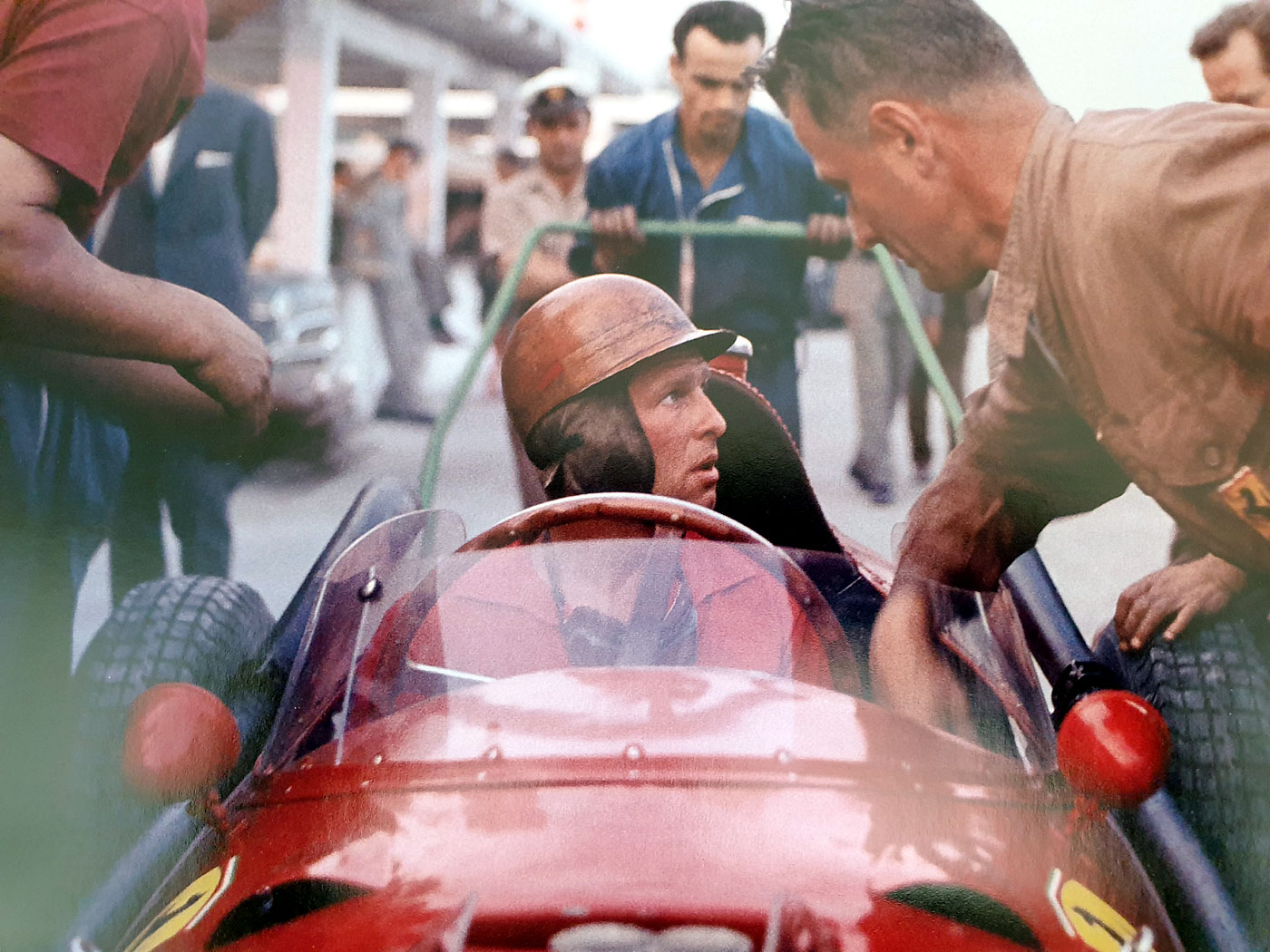 Here is Peter again at the Modena autoaerodromo in the fall of ’57, looking very serious while testing the new Dino 246 GP car which would take his “mon ami mate” and teammate Mike Hawthorn to the World Championship in 1958.
Here is Peter again at the Modena autoaerodromo in the fall of ’57, looking very serious while testing the new Dino 246 GP car which would take his “mon ami mate” and teammate Mike Hawthorn to the World Championship in 1958.
Peter and his new wife Louise were together at Monaco, they seemed so happy and still on their honeymoon. The joy and informality made me feel I could approach him and ask for a comment on the previous week at the Mille Miglia. I told him I was sorry that he dropped out at Rome while in the lead and soon made me relax. He paused, and told me that he had felt that he could win the 1000 mile race, just like his friend Moss had done two years before. And together Moss and Collins would win the other great road race, the Targa Florio, that year for Mercedes. But 1957 would be the last Mille Miglia though I don’t think anyone knew for sure at that early date. I did keep in touch with Louise over the years after Peter’s death and she told me when she got engaged again. But there was just nobody, she said, like Peter!
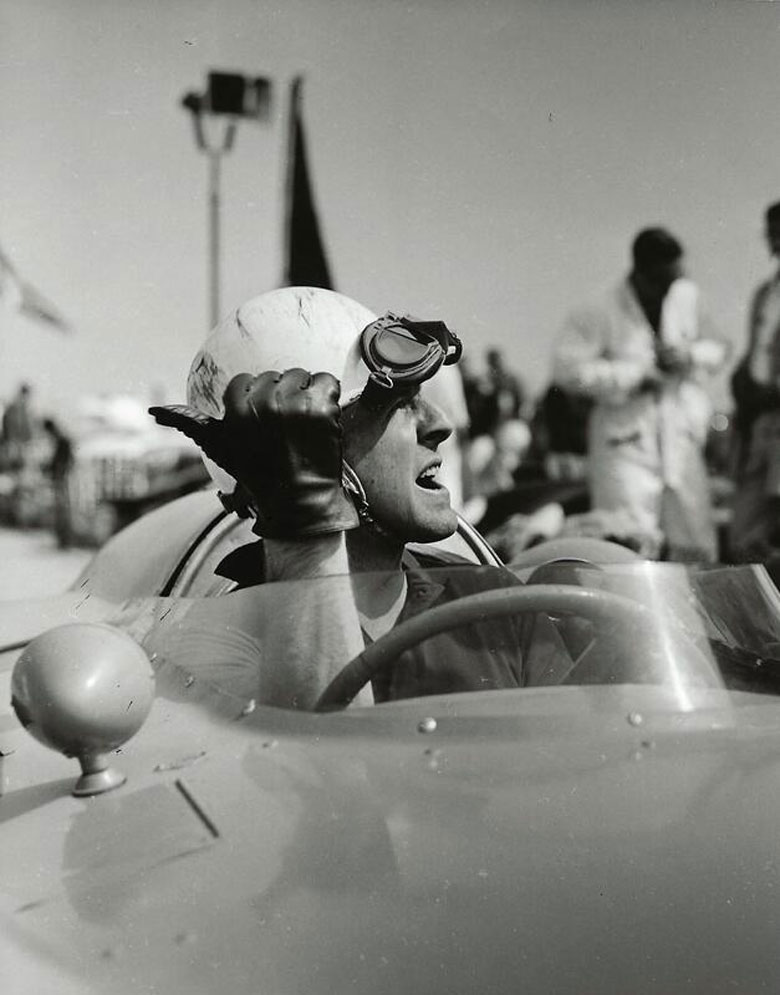 Wolfgang von Trips (4 May 1928 – 10 September 1961) did not have a good season in 1957, but proved that he was fast and reliable by finishing 2nd to team mate Piero Taruffi in the 1957 Mille Miglia. This image was taken in 1959 at the Examiner Grand Prix at Pomona CA, his first visit to the West Coast, where he was a guest at a fine Hollywood Hills home. The hostess told me later that von Trips was the perfect gentleman, both considerate and unassuming. Unfortunately, the loaner car for the event was a worn-out Cooper Climax which gave him little chance to display his talents.
Wolfgang von Trips (4 May 1928 – 10 September 1961) did not have a good season in 1957, but proved that he was fast and reliable by finishing 2nd to team mate Piero Taruffi in the 1957 Mille Miglia. This image was taken in 1959 at the Examiner Grand Prix at Pomona CA, his first visit to the West Coast, where he was a guest at a fine Hollywood Hills home. The hostess told me later that von Trips was the perfect gentleman, both considerate and unassuming. Unfortunately, the loaner car for the event was a worn-out Cooper Climax which gave him little chance to display his talents.
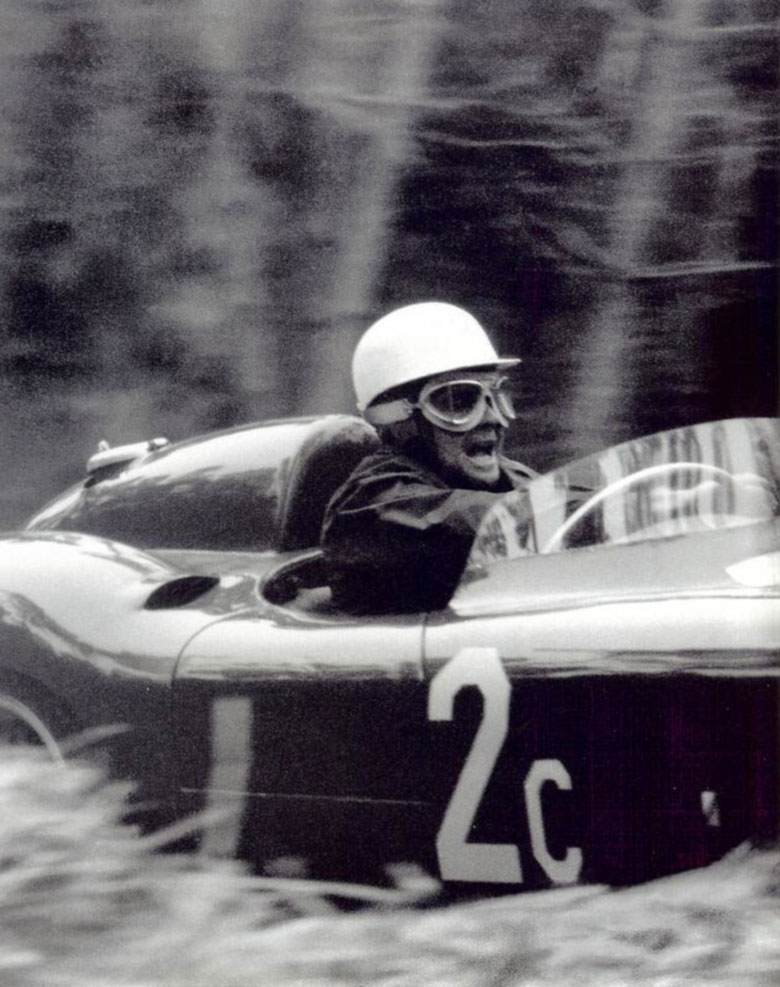 Phil Hill (20 April 1927 – 28 August 2008) having a little car control problem at Pebble Beach in 1956. He had just returned from towing the 860 Monza across the US. A story about Phil that I recall was in the fall of 1957; I was at the Modena test track and had a letter from Mr. Ferrari that invited me to see his factory in Maranello. At the track, I showed the letter to Ferrari team manager Romolo Tavoni, who said he would come by in the morning and pick me up at the hotel. When the car arrived to my surprise in the car was Phil Hill, who then engaged in a heated argument with Tavoni. Phil was eager to drive F1. I had to suppress my laughter when Tavoni kept saying, “Be patient, be patient!” I recall that Tavoni was not a great driver, and the road was full of bicycles, making the trip quite eventful.
Phil Hill (20 April 1927 – 28 August 2008) having a little car control problem at Pebble Beach in 1956. He had just returned from towing the 860 Monza across the US. A story about Phil that I recall was in the fall of 1957; I was at the Modena test track and had a letter from Mr. Ferrari that invited me to see his factory in Maranello. At the track, I showed the letter to Ferrari team manager Romolo Tavoni, who said he would come by in the morning and pick me up at the hotel. When the car arrived to my surprise in the car was Phil Hill, who then engaged in a heated argument with Tavoni. Phil was eager to drive F1. I had to suppress my laughter when Tavoni kept saying, “Be patient, be patient!” I recall that Tavoni was not a great driver, and the road was full of bicycles, making the trip quite eventful.
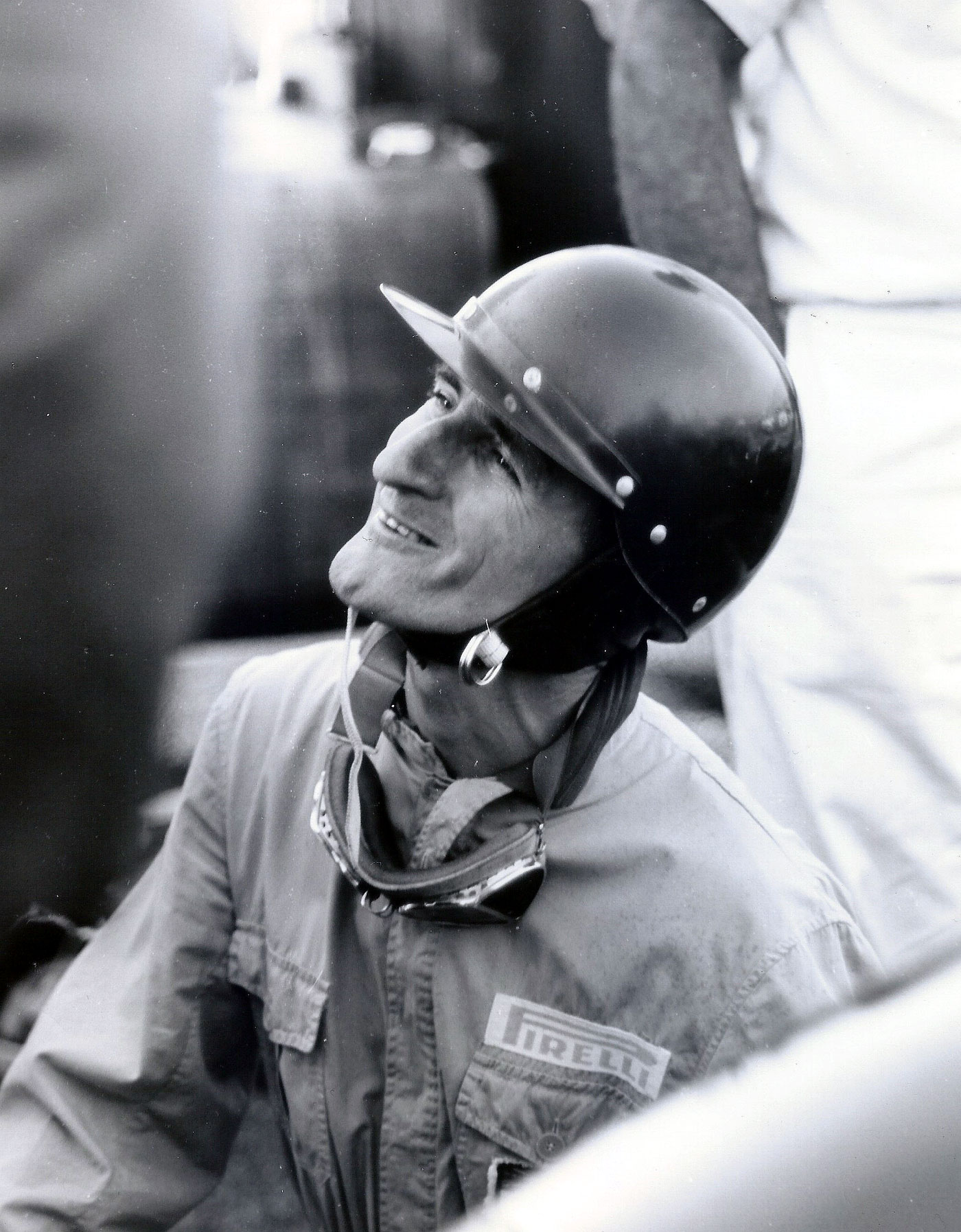 Ken Miles (1 November 1918 – 17 August 1966) was known as “Mr. MG” for his MG specials in the early days of racing in California. His talent allowed him to find faster mounts, first Porsche then with the Shelby team. Witty, caustic, and very funny, he will always be remembered for being portrayed in the movie Ford vs Ferrari. Here I photographed Ken on an evening pit stop at Pomona, 1958, which he won driving a D-Type Jaguar owned by his close friend Carlyle Blackwell.
Ken Miles (1 November 1918 – 17 August 1966) was known as “Mr. MG” for his MG specials in the early days of racing in California. His talent allowed him to find faster mounts, first Porsche then with the Shelby team. Witty, caustic, and very funny, he will always be remembered for being portrayed in the movie Ford vs Ferrari. Here I photographed Ken on an evening pit stop at Pomona, 1958, which he won driving a D-Type Jaguar owned by his close friend Carlyle Blackwell.
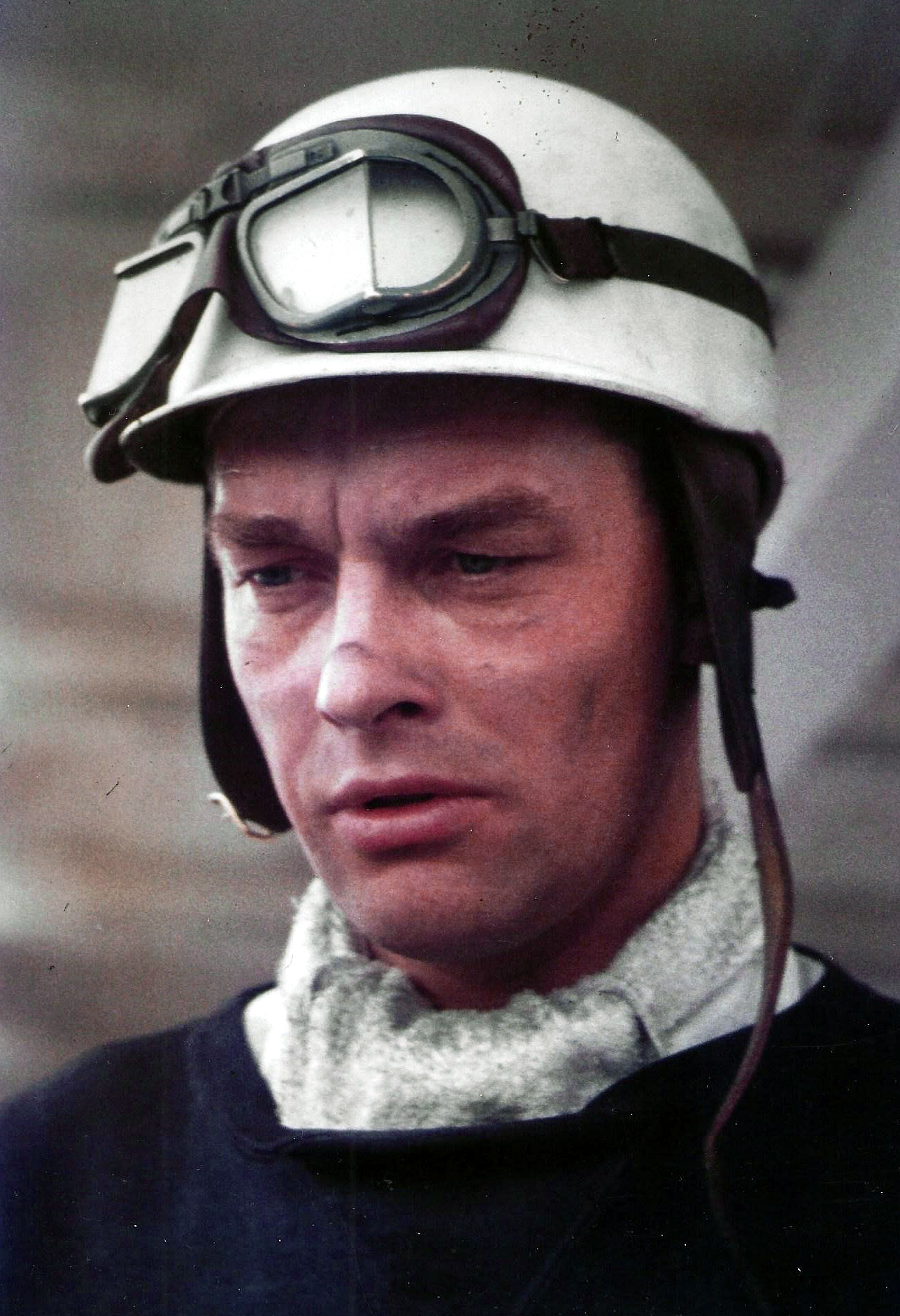 Ron Flockhart (16 June 1923 – 12 April 1962) was certainly in the news in 1957, having won at Le Mans for Jaguar, and here in Sweden for Ecurie Ecosse. The Scottish driver began racing in a vintage ERA and by 1957 got to drive for BRM but was replaced by Schell and Behra in 1958.
Ron Flockhart (16 June 1923 – 12 April 1962) was certainly in the news in 1957, having won at Le Mans for Jaguar, and here in Sweden for Ecurie Ecosse. The Scottish driver began racing in a vintage ERA and by 1957 got to drive for BRM but was replaced by Schell and Behra in 1958.
Juan Manuel Fangio (24 June 1911 – 17 July 1995) arrived at the Nürburgring on August 4th, 1957 just a short time before the race, appearing very relaxed, which allowed him a rare winning smile which I caught on film. Perhaps he knew this was going to be ‘his’ day.
That afternoon Fangio drove the race of his life. While leading the race he suffered a disastrous pit stop, dropping him to third place behind Ferrari-mounted Peter Collins and Mike Hawthorn. Lap after lap Fangio broke the lap record, gaining on the British duo.
Phil Hill and I watched as Fangio, his Maserati with two wheels on the grass, got past Collins, a tight squeeze, but clean, and then simply drove out of sight as he hunted down Hawthorn. Just like in the movies, we heard the crowd roar as Fangio nailed Hawthorn for the win. Not only did he win the race but gained enough points to secure the World Championship.
I was awe-struck and even Phil was amazed. “The man’s not human!” he shouted, while I stood there open-mouthed. We had just witnessed what many still believe is the greatest race of the 20th century.
I failed to capture Fangio’s pit stop which changed the entire nature of his drive. I was on the big scoring tower instead of in the pits. But I did get a chance to shoot Fangio going into a corner with the famous castle in the background. And this eventually ended up as the cover for Chris Nixon’s book Kings of the Nürburgring.
However, I was in the pits at the end of the race when Collins and Hawthorn came in. On might expect that they would have their tails between their legs and fearing Mr. Ferrari, but that was not the case. Peter and Mike did not look the least bit embarrassed; they were all grinning fools and joined us in the laughter over the outcome. Everyone there was on a high and no one wanted to leave. While in the pits, Hill introduced me to the guys from N.A.R.T., like Jan de Vroom, who showed up in a magnificent metallic blue 4.9 Ferrari SuperAmerica hot from the Turin Motor Show.
Finally, we had to return to eat at the old inn with Phil, Jesse Alexander, and the N.A.R.T. team. One of the N.A.R.T. guys teased Phil, saying that he saw Denise McCluggage headed toward his room late at night. Phil got properly embarrassed! After our meal, they were off to the lodge where they all had stayed, while I slept in a farmer’s barn near the track. It was all like a dream.
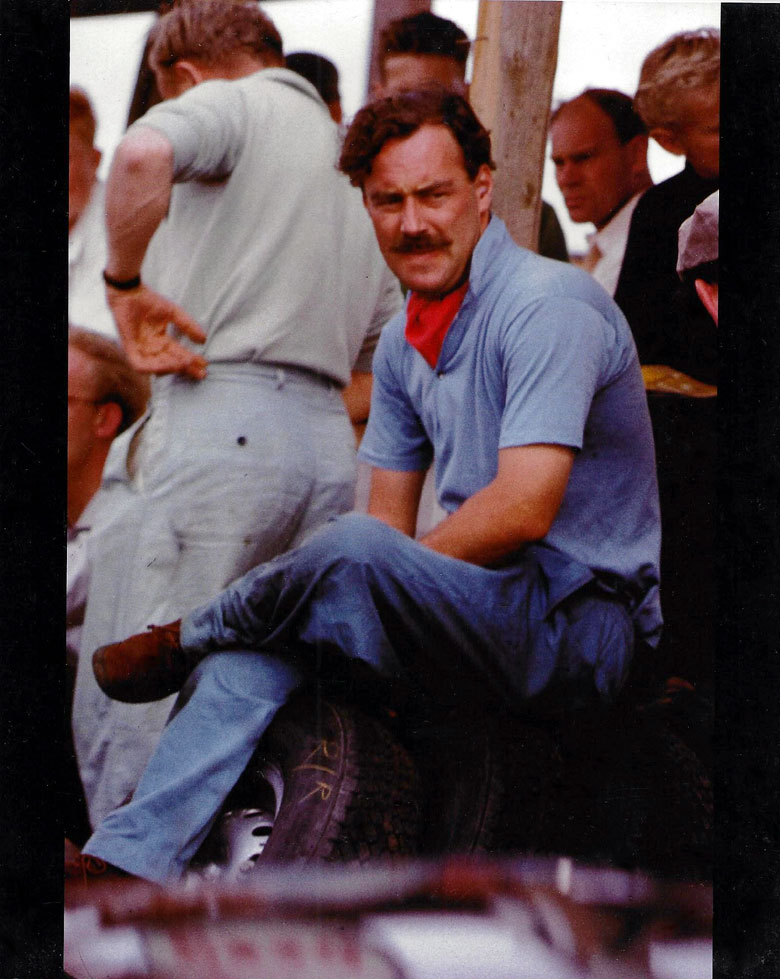 I was already impressed with Archie Scott Brown (13 May 1927 – 19 May 1958) after reading about his epic battle with Moss in Grand Prix cars, but was really dazzled when I saw him driving a D Type Jag in Sweden, using his one normal arm shift gears and holding the wheel in the meantime with his other arm, shortened just below his elbow, to steady the wheel while shifting. In this photo I made an effort not to bring attention to his malformed arm. Nothing slowed this courageous man down, and did not want to be denied the chance to race.
I was already impressed with Archie Scott Brown (13 May 1927 – 19 May 1958) after reading about his epic battle with Moss in Grand Prix cars, but was really dazzled when I saw him driving a D Type Jag in Sweden, using his one normal arm shift gears and holding the wheel in the meantime with his other arm, shortened just below his elbow, to steady the wheel while shifting. In this photo I made an effort not to bring attention to his malformed arm. Nothing slowed this courageous man down, and did not want to be denied the chance to race.
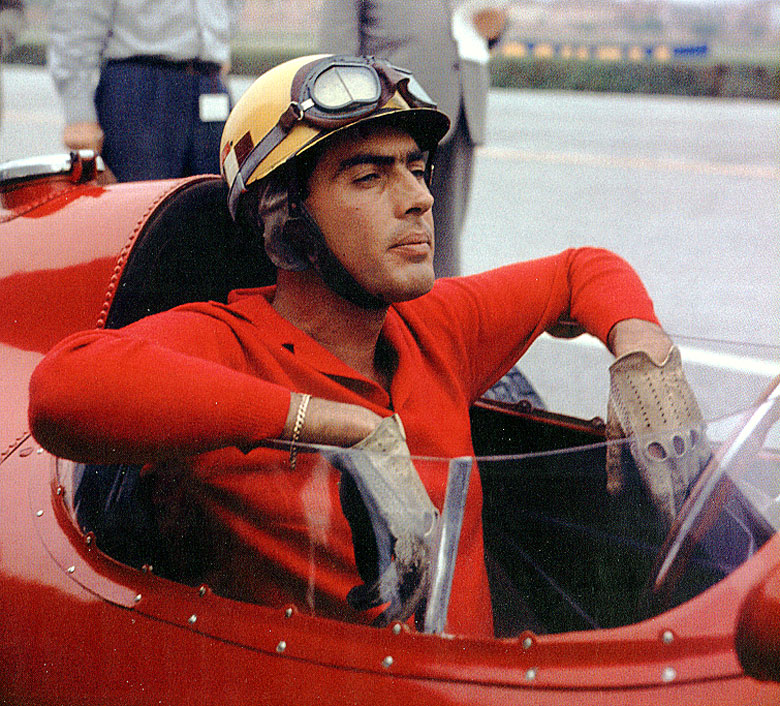 Luigi Musso (28 July 1924 – 6 July 1958) With the death of Eugenio Castellotti in March of 1957, Luigi Musso became the only top Italian driver. A Roman, handsome man with fine features, but thin, almost frail looking. After a race he was so exhausted, and it seemed to me that he pushed himself too hard, trying to match the pace of his British teammates. That summer, he did win the French Grand Prix at Reims after the leading Vanwall retired. This image, taken in the mellow fall in Modena, testing the new Ferrari Dino. Musso appears calmly apprehensive as mechanics fiddle with the new car.
Luigi Musso (28 July 1924 – 6 July 1958) With the death of Eugenio Castellotti in March of 1957, Luigi Musso became the only top Italian driver. A Roman, handsome man with fine features, but thin, almost frail looking. After a race he was so exhausted, and it seemed to me that he pushed himself too hard, trying to match the pace of his British teammates. That summer, he did win the French Grand Prix at Reims after the leading Vanwall retired. This image, taken in the mellow fall in Modena, testing the new Ferrari Dino. Musso appears calmly apprehensive as mechanics fiddle with the new car.
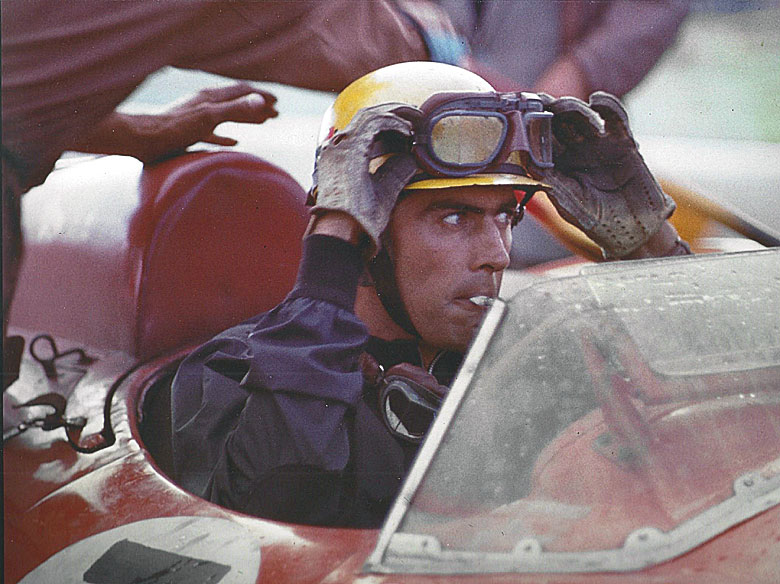 Being a non smoker it is hard for me to understand why others smoked but it was so common in the 1950s that no one even cared if Musso was smoking while gas was being poured into the car. I can’t imagine this in the pits today! This is Musso in the Ferrari 335 he shared with Hawthorn at the 1957 Swedish Grand Prix. Ironically Musso died at Reims in 1958, possibly trying to emulate Fangio by taking the Courbe du Calvaire flat out.
Being a non smoker it is hard for me to understand why others smoked but it was so common in the 1950s that no one even cared if Musso was smoking while gas was being poured into the car. I can’t imagine this in the pits today! This is Musso in the Ferrari 335 he shared with Hawthorn at the 1957 Swedish Grand Prix. Ironically Musso died at Reims in 1958, possibly trying to emulate Fangio by taking the Courbe du Calvaire flat out.
Stirling Moss (17 September 1929 – 12 April 2020) With Stirling winning several events in the Vanwall, it made the year 1957 even more vintage. His last two wins that year were in Italy, just to rub their nose in it, at Pescara in August 18th and Monza on September 8. In Sweden on August 11, where he won the sports car race in a Maserati with Jean Behra, I watched as he practiced the Le Mans start…I swear that the moment his butt hit the seat the motor fired and he was off. The photo I took of that was last seen in the office of Sports Cars Illustrated. Never got it back. This photo is the only one left of that moment with Moss in Sweden.
In Sweden, I was much too shy to speak to many drivers, as I was just 18 at the time. But by Monza, I did speak to him and told him I was happy that he won in the Vanwall. And of course, so was he! In the paddock, he still had the Mercedes 220 in British Racing Green given to him by Mercedes in 1955. He washed the car himself because according to his buddy Denis Jenkinson; Mercedes paid him an allowance for such maintenance and Stirling would pocket the five shillings by cleaning the car himself.
I am not sure why Moss had the somewhat strange expression in this photo. Jenks liked the photo a lot as did Suzie Moss many years later. When I met them both at a special luncheon in London in 2015, Moss was still just as sharp as ever.
I thought he was the best driver of my generation.
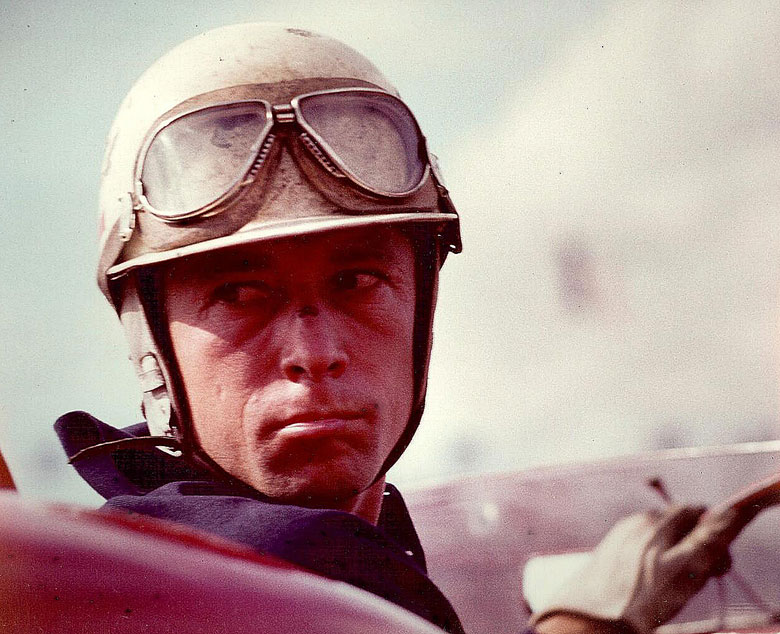 Oliver Gendebien (12 January 1924 – 2 October 1998) made his name in the summer of 1955 after taking his own Mercedes 300SL to enter road racing events in Europe and often beating the Ferraris in his class. Enzo noticed him and by September he was driving for Ferrari. His drive in the last Mille Miglia in 1957 garnered him a third overall driving a Ferrari GT coupe. This image was shot in Sweden in August of 1957 as he checks pit traffic before pulling out in the works Ferrari Testa Rossa. It required some patience to get the shot I wanted and I used the long lens on the Swedish Hasselblad, which sure paid off.
Oliver Gendebien (12 January 1924 – 2 October 1998) made his name in the summer of 1955 after taking his own Mercedes 300SL to enter road racing events in Europe and often beating the Ferraris in his class. Enzo noticed him and by September he was driving for Ferrari. His drive in the last Mille Miglia in 1957 garnered him a third overall driving a Ferrari GT coupe. This image was shot in Sweden in August of 1957 as he checks pit traffic before pulling out in the works Ferrari Testa Rossa. It required some patience to get the shot I wanted and I used the long lens on the Swedish Hasselblad, which sure paid off.
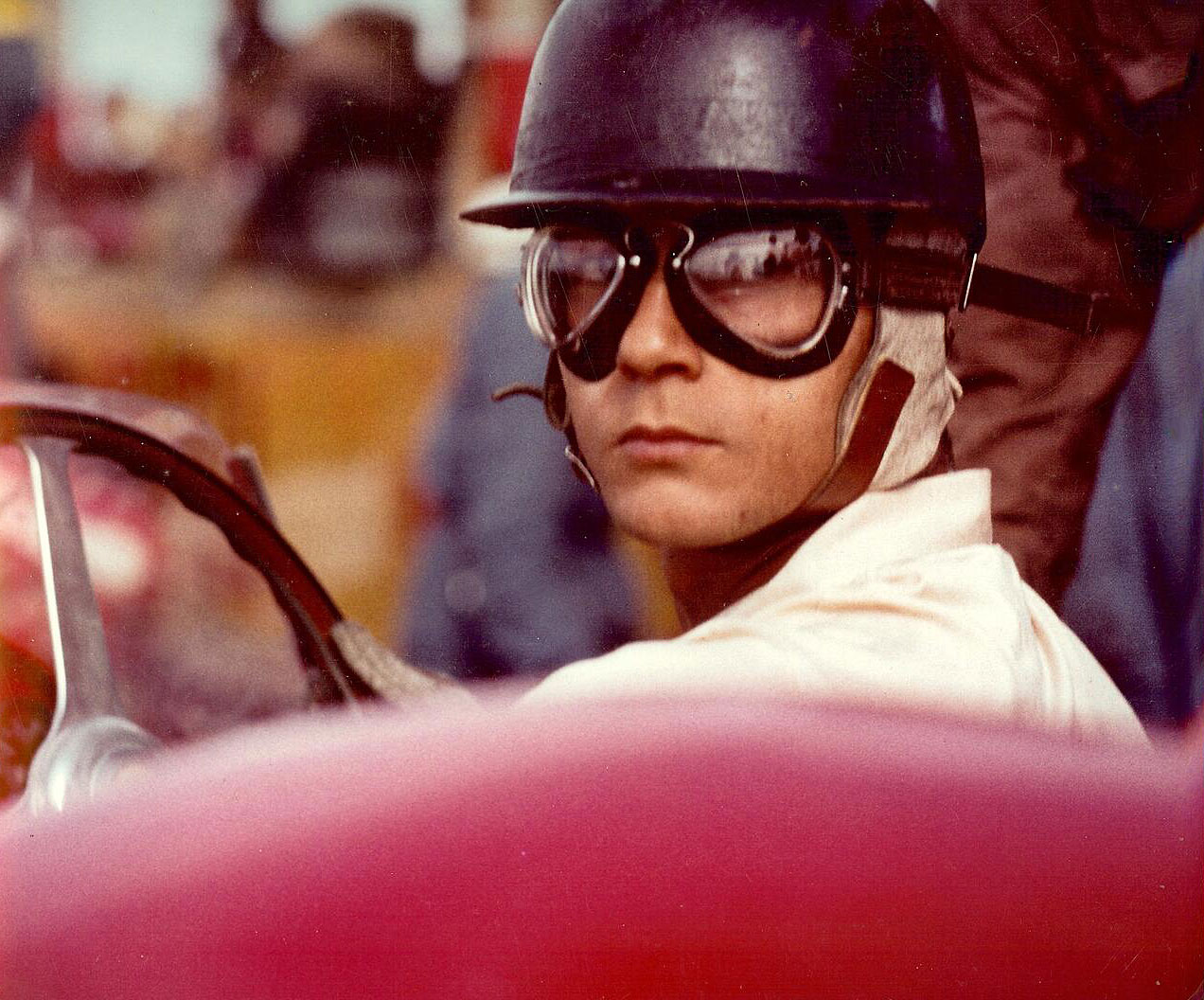
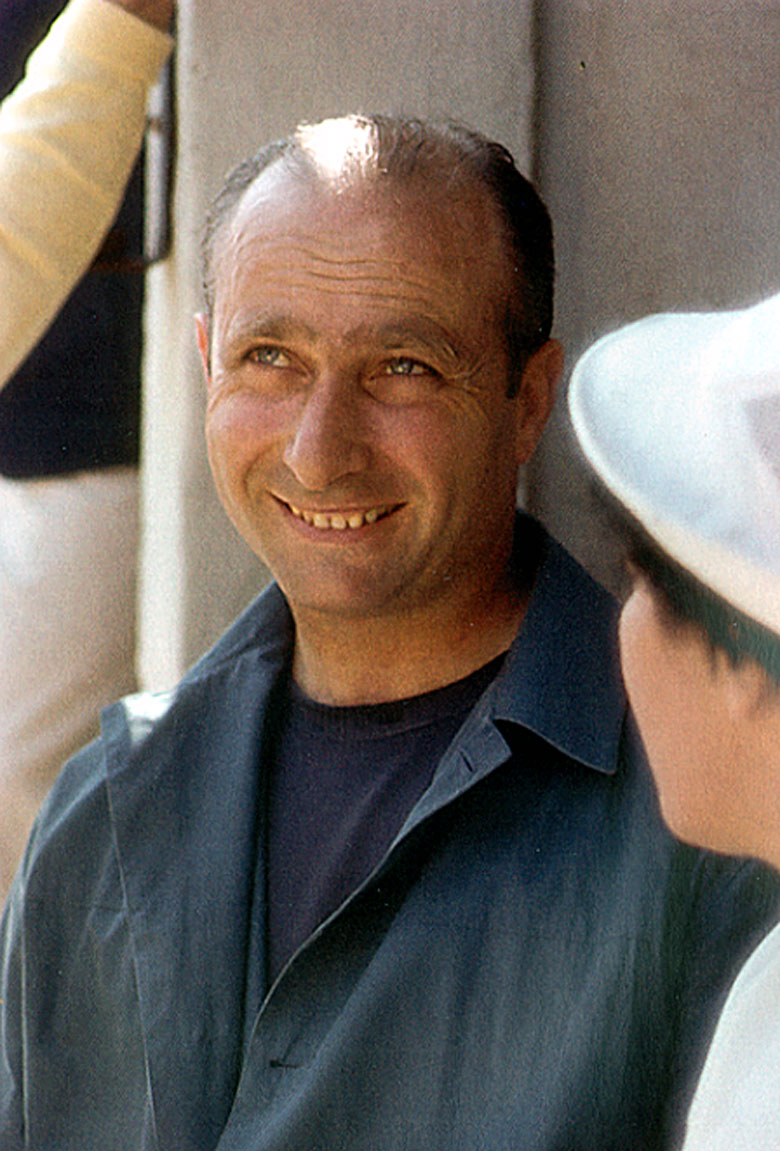
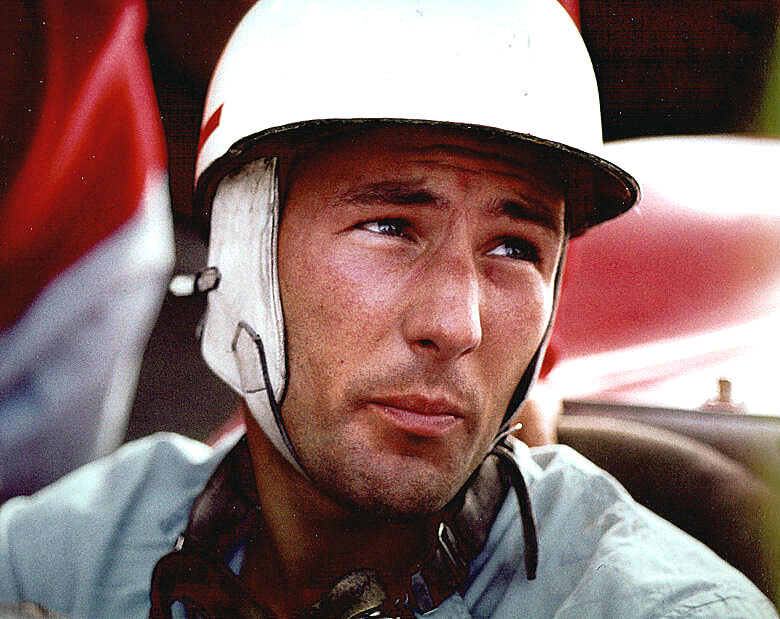
Great stuff, and brings back memories…although I did not have the good fortune to meet all of these fellows and only shook Fangio’s hand in a reception line. Still, getting to know Moss a bit and P Hill quite well gave me currency that still provides drinks and the occassional dinner. Keep the faith…
Fantastic! Thank you Jim and Peter. The pictures are great and the stories even better. What a thrill it must have been to experience the idea of going off to Europe and following your dreams. To see pictures of these famous drivers up close then in old magazines makes it more special. The casualness but expertise of the pictures are truly wonderful. Bravo!
Wonderful photos of amazing guys.
Perhaps even more powerful because they are focused on them as men and not just drivers.
But what drivers!
Thank you
A great set of pictures. Usually all you see is goggles and road grit on their faces. I got to see some of these guys race in the early sixties, and remember them all from Road & Track reports in the 1950s.
Wonderful portraits. Thank you.
I haven’t seen many close-ups of helmeted and goggled racing drivers that have made a greater impression on me than Jim Sitz’s portrait of Masten Gregory. A genuinely poetic image, it seems to sum up a whole lost era. Thanks for letting us see it — and the rest of Jim’s wonderful gallery.
Great photos and comments! Thanks for sharing.
Just amazing photos and stories. I started following road racing in 1957 and these brought back wonderful memories. Thank you.
I have the distinct privilege to communicate with Jim almost every day via email. We both now live in Oregon. Speaking with Jim is just like having a Time Machine that takes you back to those golden years ! For those not fortunate enough to have witnessed these warriors in person, Jim’s photos and descriptions are priceless to those unlucky souls. Thanks Jim for sharing your experience’s with us all…Jack
Superb photographs from one of our best historians today–Jim Sitz. Thank you for sharing them!
There should be a book of these masterful images along with so many others of Jim’s work. His comments with them doubles the value and his personal reflections of the series. Very perceptive for an 18-year-old to know how to capture the essence of these gladiators preparing to do battle. Well done, Lad. Allen R Kuhn
P.S. I noticed that all of the images were not posed shots, just natural feelings of the drivers. Especially Hill singing an aria from his favorite opera . Allen
In spite of those marvelous images taken, the adventurous 1957 trip wasn’t all fun for the 18-year-old Jim Sitz. At the end of his trip, by now in Italy, his expensive Swedish camera got stolen, while several precious rolls of film -mailed back to the US for developing- never arrived there and were lost. Upon his return by steamer in NYC, Jim had to find a temporary job to be able to fund reclaiming his VW. Once accomplished, the journey back to California seemed to take an eternity, especially crossing the state of Texas, which took an entire day. Jim must be complimented for his perseverance at that young age.
Superb images and exacting captions, the pure artistry brought to pictures and words by the professional photographer and historian we so much admire, Jim Sitz. What a treasure he is!
Looking at these photos and reading the captions made me feel like I had snuck into the pits. My thanks to Pete and Jim.
Just great images. Thanks Jim.
I was 17 in the summer of ’57, and already a sports car racing fan.
Jim makes me jealous that I didn’t have guts that he did in making the trip to Europe.
After working in a sports car shop,
I did follow in 1959 courtesy of Uncle Sam !
Got to the ‘Ring once, but regret not getting to LeMans in 1960 to see the Cunningham Corvettes. Afterward to my chagrin, I learned that Briggs welcomed GI’s to aid his team.
But, not much you could do on $120 per month !
What a great Era……
I was present in Havana in 1957. My crazy Uncle Armando took me to see the practice from the 2nd story building at the back of the course. My Uncle thought that James Cagney and Juan Fangio were Gods. He told me to watch Fangio, but I was totally unimpressed. He came by looking very slow barely making the tires cheeped. But Portago and Masten Gregory came by (as they say) all arms and elbows, Gregory especially. To my surprise, Fangio set fastest time. It was the beginning of my education. Later Portago’s car came to a halt, he stood up in the car, cross the street and bum a cigarette from a good looking girl. At that time I thought it was the coolest thing I have ever seen. I wanted to be Portago, because I knew there was nothing cool about me. Later I watched Gregory on the main straight of the course, he was flying. At that moment I became a Masten Gregory fan for life. These photographs have made it all come alive for me again. God bless Jim Sitz , thank you for being there, thank you for making it all come alive, to an old guy.
Is it possible to get a print of these portraits. Especially Masten and Moss? Do you have a contact for Mr. Sitz. If possible I look forward to getting a photograph of my heros to go with my wall of Jesse Alxander photographs.